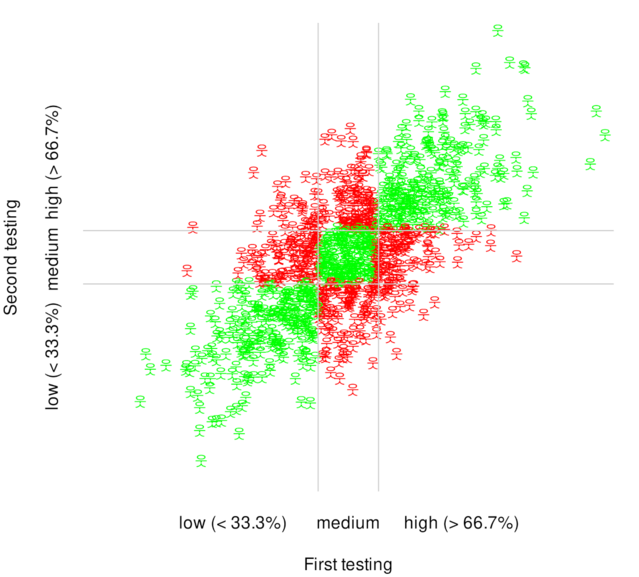Personality
Will Your Personality Change in the Next 6 Years?
Most people change in some way.
Posted February 26, 2022 Reviewed by Vanessa Lancaster
Key points
- Every third adult is expected to change in any personality trait over the next few years.
- Nine in ten adults will change in at least one Big Five trait over the next few years.
- Most changes happen between medium and high-low trait levels, not between extremes.
Being a personality psychologist, I am often asked: Do people change? I answer by showing how likely someone’s personality test feedback changes over time.
But first, it is useful to know that there is more than one way people can change.
Changing With Others or Against Others
For example, normative changes characterize people generally—how an average person changes with age. As for the Big Five personality traits, Agreeableness and Conscientiousness tend to increase slightly between 18 and 50, while Neuroticism decreases slightly, on average. Some argue these normative changes reflect universal biological maturation. Others think they are due to the expectations of typical adult life.
But the traits of individual people don’t have to follow the normative trends, changing either more, less, or even in a different direction. Imagine a nervous student being among the most relaxed adults at a class reunion 20 years later—while most of the class has become less nervous over time, he has changed more than others. This may be because of his unique experiences or biological makeup, happenstance, or any combination of these.
The normative changes are usually slow and gradual for adults. Also, personality test feedback is often based on comparing people’s scores to others of similar age, stripping them from normative changes.
So, here I focus on the probability that individuals' trait levels change in comparison to trait levels of other people, regardless of any normative changes.
This is studied by asking many people to complete a personality test twice over several years and calculating correlations between trait scores from the two time points. A correlation of 0 means that people’s scores from the first test say nothing about their scores at the second testing. A correlation of 1 means that people did not change compared to others.
In a summary of many such studies, the correlation between adults’ test scores separated by six years was estimated at 0.70.
What Does This Mean for Your Personality?
Let’s assume that you are in your thirties or older and do a Big Five personality test. For each trait, you receive one of these three feedbacks: low (lowest third in your age group), high (highest third in your age group), or medium (the middle third). You take the test again in six years.
With a correlation of 0.70, it is about a 60 percent probability that you will get the same feedback for any given Big Five trait both times. In other words, you are expected to get the same result for three of the five traits.
To picture this, look at the graph below where hypothetical people’s test scores from two testing occasions are plotted. The green people (about 60 percent) are those with matching test scores on both occasions, while the red people (about 40 percent) are those getting a different score next time.

Besides real trait change, you can get a different result because personality tests are not perfectly reliable. For example, even if you did the test again next week and your trait levels were still the same, the scores would correlate somewhere around 0.85, depending on how good the test was. This shows how high the correlation between test scores over six years could be in principle, with perfect reliability, and allows correcting it accordingly: 0.70 / 0.85 = 0.82.
This correction gives you about a 65 percent probability that your personality trait level stays the same over six years compared to other people, being either low, medium, or high.
Put differently, this means there's about a one in three chance that you will change in any given Big Five trait over the next six years. In most cases, the medium trait level turns into high or low or the other way around. Switching between high and low trait levels is rare.
Almost Everyone Changes in at Least One Trait
The chances of getting similar feedback twice for all five traits are much lower. This is because the probabilities of change add up across traits.
Even with perfect reliability, the probability of getting the same feedback for all traits is only 12 percent, because 0.65 x 0.65 x 0.65 x 0.65 x 0.65 = 0.12. With imperfect reliability, it is below 10 percent.
So, about nine in ten adults are expected to get a different result for at least one Big Five trait in six years.
Younger People Are More Likely To Change
In early adulthood, the correlation between test scores obtained six years apart is lower, about .60. For example, when you complete a test at age 18 and again at age 24, there is less than a 55 percent probability that you will get the same feedback for any given Big Five trait. Even with perfectly reliable measurements, the probability would still not be much higher than 60 percent.
Personality trait change is even more likely earlier in life. About half of adolescents switch their relative positions in any given personality trait for a few years—switching positions in at least one of the Big Five traits is almost guaranteed. Most switches happen between medium and high or low trait levels, but moving from one end of the trait to another also happens.
This means that the personality traits of youth do not allow very accurate predictions of someone's personality traits in adulthood.
Personality Trait Change Is Normal
So, your personality is quite likely to change within the next six years, especially if you are young.
For example, chances are at least one in three that the feedback that you get for any given Big Five trait changes. Looking at all five traits simultaneously, there is about a nine in ten chance that the feedback changes for at least one of them.
And that was the probability of changing in six years. Over more extended periods, personality trait change is even more likely.
Facebook/LinkedIn image: GaudiLab/Shutterstock




